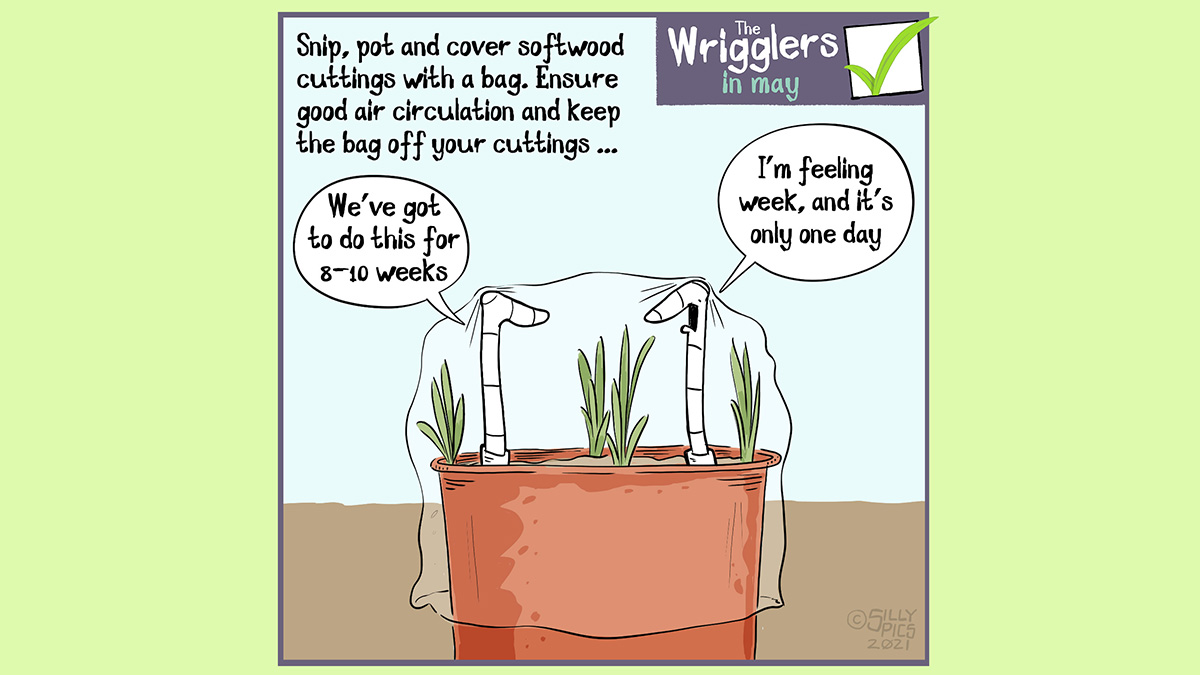The worms have spent some time thinking of tasks in the garden for May this week. There’s quite a few to dos, like taking softwood cuttings. Plants for free, basically. Follow our blog to get more daily gardening cartoons, ideas, tasks and tips.

[elementor-template id=”1680″]
The wrigglers are amateur gardeners, for advice from the experts on how to take softwood cuttings, try the RHS – they know what they’re talking about!
Softwood cuttings can be used to propagate a wide range of perennials and deciduous shrubs, as well as some trees, in spring and early summer. Material is taken from the soft and flexible young shoot tips, which root readily.
The Wrigglers have joined the #putpollinators first Campaign
Wild flower meadows flower for longer due to the diverse range of plants in them. That’s more flowers for you, and more food for the bees and insects. Plant one and join the Gardener’s World Put Pollinators First campaign – raising awareness of the decline of our pollinators @GWmagazine
Click to see our ‘Put Pollinators First’ page
Gardener’s world launched its #putpollinatorsfirst campaign, as part of their 30th Anniversary celebrations of BBC Gardeners’ World Magazine. See what you can do to play your part:
Join in the Gardener’s World team and pledge here
With a panel of pollinator experts, committed to helping bees and other pollinating insects to thrive, Dr Trevor Dines says, ” Since the 1930’s, over 97 percent of our wildflower meadows have been destroyed. That’s 7.5 million acres, gone. Now you can understand why our pollinators are in such trouble.”
There are 3 ideas:
Sow some pollinator meadow seeds
Create habitats for butterflies, moths and caterpillars
By making a meadow, even on a small scale, we can provide a banquet for pollinators that’ll help them to thrive.
Here are some seed suppliers and links:
Thomson and Morgan – how to sow wildflower seeds
RHS – How to grow a mini wild flower meadow
More from the worms
Year-round garden pruning guide
Great advice and full of quick and simple tips too, for example … don’t cut into tender plants or evergreens right now as their top growth provides insulation from penetrating cold.
[elementor-template id=”1721″]
#trees #rhubarb #compost #composting #greenwaste #brownwaste #flower #nature #gardening #garden#art #wildlife #cartoons #thewrigglers
@GardenOrganicUK
@The_RHS
@RHSBloom
@RHSSchools
#garden @The_RHS
#gardener#gardens#instagarden#gardeningtherapy#gardenerslife#instagardeners#gardenlovers#ediblegarden#urbangardener#growfoodnotlawns
@AmateurGardeningMagazine @GardenNewsOfficial @mr_plantgeek
